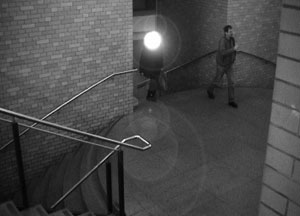Nice concept! But did it work?
An old Hackaday article from the same year and a subsequent Instructable kind of took the piss out of the German project. It would work but only under certain conditions and only so well.
A tumble down this research rabbit hole was riddled with various "cloaks of invisibility".
2008 was a big year for wearable commentary on technological observation. This Instructable (pictured left) was more public statement than technical solution.
Living under the scrutiny of potential surveillance, as Jacques Lacan notes, has an impact on the behavior of those observed. Digital surveillance and the mass analysis of subsequent data has become the norm and it is changing the way we live. What Lacan referred to as an "invisible omnipresence" creates a self-enforcing system wherein subjects do not deviate from established norms of behavior. Individuals will, in fact, alter their behavior on the assumption that they are being monitored. The power of this system is derived from the uncertain and unverifiable nature of this observation. Attempts to circumvent this system also qualify as alterations of behavior - as their very inception requires a paranoiac world-view. Brooklyn artist Adam Harvey has made several attempts to mask people from the eye of the "invisible omnipresence" by working to circumvent specific technologies. Harvey implements design to overcome design.
Harvey's project Stealth Wear fittingly opened in London, home of Jeremy Bentham, philosopher and the creator of the panopticon (a hypothetical design for prisons which allowed one guard to observe all inmates). Stealth Wear is a line of techno-fashion intended to spark a discussion on the aesthetics of privacy and to challenge surveillance policies Harvey views as authoritarian and overreaching. This line includes clothing designed to interfere with the computer vision of drone aircraft, pockets to block cell transmissions, and shirts that react to x-ray examination.
Prior to CV Dazzle was Harvey's more conceptual and far less material Camoflash, a handheld device intended to defeat photo surveillance using a flash of light to create blind spots in a photo. I imagine that strobes of light would be likely to draw immediate attention to the individual seeking not to be surveilled The direction nature of this device also seems to make it impractical.
Conclusion:
Attempts have been made to circumvent surveillance technologies utilizing aesthetics. Conceptual fashion may become utilitarian in a world of indefinite observation and examination. However, my initial comparison of contemporary digital culture and the prison culture of the panopticon is imperfect. In Bentham's panopticon the crowd was eliminated and individuals were isolated and unable to communicate. The global networks that are the mechanism of contemporary surveillance are also the tools of connection giving voice to every user.
Within each technology is the seed of its undoing.




